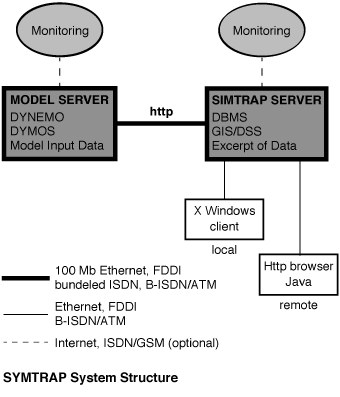Integrated Traffic and Air Quality Simulation
by Matthias Schmidt, Birgit Kwella, Heiko Lehmann, Christian Motschke
and Ralf-Peter Schäfer
The aim of the project SIMTRAP (HPCN Simulation of Traffic Induced Air Pollution Using Parallel Computing in a Distributed Network) is to create an integrated simulation system for modelling both the traffic and the air quality, particularly for medium term planning. The system will be able to address most issues of the transport-environment link, such as traffic volumes, demand profile, and fleet composition from the traffic point of view, and (industrial) sources of pollutants, orography of the model area, land use, and meteorological conditions from the air pollution side. SIMTRAP is a European cooperation project funded by the European Commission within the ESPRIT Programme.
The link between vehicular traffic and air pollution is well established. For example, road traffic accounts for more than 70% of the overall nitrogen oxides and more than 55% of the overall volatile organic compounds emission in the Berlin region. For this reason, authorities in urban areas need support in managing road traffic so as to avoid exceeding pollution limits during hot summer periods. To date, much of the past modelling work concerning transport and air pollution has concentrated on long term strategies, where the effects on air quality indirectly may be expressed through energy use and emission reduction.
The increasing demand on the travel system and the tightening of many environmental standards, however, require to focus more on developing medium term strategies, eg on strategies during the closure of streets due to adverse meteorological conditions or severe reconstructions, or the guidance during special events. For developing medium term strategies, the demand on integration between the traffic models and the air quality models is the highest. Integrated dynamic tools are required to assess alternative strategies, and to select the most appropriate one.
 The SIMTRAP System
The SIMTRAP System
SIMTRAP centres around two well-established core components: the mesoscopic dynamic traffic model DYNEMO (Dynamic Net Model) and the air pollution model system DYMOS (Dynamic Models for Smog Analysis). Due to the complexity of the simulated processes, both modules are being implemented in a remote HPCN environment. The simulation results will be visualized in a local 3D Geographical Information System with built-in functionality for decision support. Communication is realized using existing computer networks and standard protocols.
The Models Used in SIMTRAP
DYNEMO is a simulation tool for both urban and rural road networks. It has already been used to simulate large parts of the German motorway network. Regarding the movement of vehicles, DYNEMO is a mesoscopic model in the sense that it combines properties of both microscopic and macroscopic models. As in microscopic models, the unit of traffic flow is the individual vehicle. Their movement, however, follows the approach of macroscopic models and is governed by the average traffic density on the link the vehicles travel.
DYMOS is a simulation system to analyse the generation, dispersion, and chemical transformation of gaseous air pollutants and different aerosols. The model is well suited to reproduce most frequent occurring kind of smog situations, in particular summer smog which is mainly caused by traffic emissions.
SIMTRAP Applications
Besides GMD Institute for Computer Architecture and Software Technology, Berlin, SIMTRAP involves participants from Austria, Italy and the Netherlands. In order to demonstrate the functionality of the system and to validate the obtained simulation results, the SIMTRAP prototype will be applied by potential users at the four tests: Berlin, Vienna, Milan and the Ranstaad area in the Netherlands.
All test sites differ considerably in size, geographical realities, and considered traffic network, and therefore are well suited to test the complexity of the SIMTRAP system.
More information about the HITERM project is available at http://www.first.gmd.de/applications/proj/hiterm_more.html
Please contact:
Matthias Schmidt
Tel: +49 30 6392 1815
E-mail: schmidt@first.gmd.de
